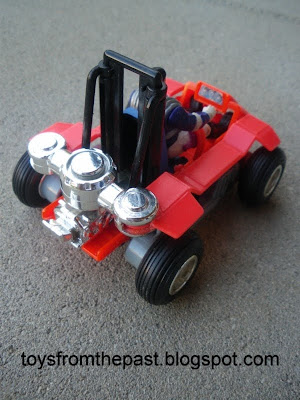“Playset” defines a group of figures and/or accessories which are sold together (generally self-contained in some kind of briefcase). Playsets are old as toys: imagine a victorian house doll, a garage for diecast cars, a Fort for cowboys which is being assaulted by Indians or Barbie’s veterinary clinic.
He-Man @ home
Castle Grayskull belongs to the Master of the Universe series. It was designed in 1981 and launched one year later. Mattel already had in stores the first 8 figures of this collection in addition to some vehicles and animals. Although it hadn't been long since the figures came out, Mattel realised, that the Collection was being a big success, and so they launched the castle Grayskull playset. This operation was not riskless, because it was a very expensive toy for those years (it cost like 6 or 7 figures), and it’s more difficult to sale, since it only makes sense when you already have some figures to “live in”.
The operation was a great success and the castle was sold during many consecutive years. In Spain it could be found until 1989, when the line was cancelled. The experience was so profitable, that Mattel made and sold other playsets with very similar characteristics in the following years: the Snake Mountain (1984), the Frigth Zone (1985) and the giant playset Eternia (1986).
The castle itself consists of two parts that hold together by means of two hinges. They allow to “close” the castle, turning it in some kind of briefcase. When closed, it’s very easy to carry, because it has a cavity which is a handle.
For playing, the playset opens leaving two fronts, (inside/ outside of the castle). The outside front is moulded with much detail (stones, slates, windows, balcony, and of course the skull at the gates), and is painted with some black spray.
Outside of the castle + details
Opened gate
The gate deserves to be commented apart, because both sides are very well sculpted, simulating teeth and tongue. It has a small bolt that allows the gate to be opened both from the inside and from the outside (using He-Man’s sword as a “key”).
The case is made of injected plastic, and the inside of the castle is the “negative” of the outside front. That’s why the interior is not so eye-catching. This little defect is hidden by the different elements to be found in each room, and the stickers.
Inside of the castle + details
The interior of the castle is divided in four rooms:
Dungeon
First room is the dungeon and the entrance of the castle. This name comes from the stickers at the floor of this room, representing the dungeon.
Throne Hall, trap and trap mechanism
Over the dungeon it’s the throne hall. This is the most beautiful room in the castle. There’s a trap at the floor which is decorated with a carpet sticker, and that can be activated by turning the throne. In this room there’s also a piece of cardboard that represents an armour (or maybe a robot) and a flag that hangs beside the throne.
On the other half of the castle, the bottom floor is the armoury, which is also the room where the elevator is found. There is another cardboard representing a weapons stand that fits in this room at best.
The elevator runs over a rail that is fixed to the case and it can be lifted by pulling from a string at whose end there’s a bat. The whole thing leaves very few space free both at the bottom and top floors.
Control Station
At the top floor its located the control station with the “supercomputer”, whose function is not clear, maybe it’s a surveillance or communications device, maybe it’s the time machine, maybe it’s both and even more!
Apart from those rooms, there are two towers, the bigger one is a vigilance tower where the flag can be clipped. The smaller tower has a cannon that takes up almost the whole space.
In the box there were 9 light gray weapons and a stand to put them on. At that point, all the weapons were new sculpts, but in the following years, they were reused for new figures (changing always the color) A training tool was also included.
Spanish promotional catalogue - Courtesy of Blade
One year later (1983), Mattel sold separately the “Point Dread and Talon Fighter”, which was an add-on to the castle, and a kind of bird/airplane (see picture above).
FACTS and FIGURES
- Name: CASTLE GRAYSKULL
- Toy Line: Masters of the Universe (Wave 1)
- Year: 1982
- Company: Mattel (U.S.A.)
- Size of the castle: 48 cm x 30 cm x 20 cm






















+%5B1600x1200%5D.jpg)
+%5B1600x1200%5D.jpg)






























